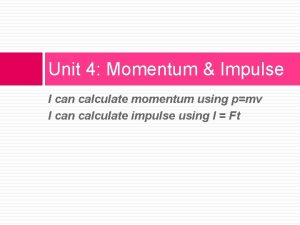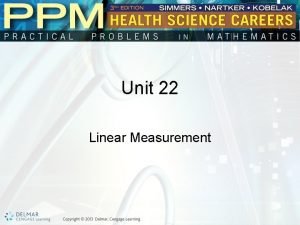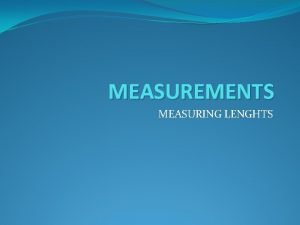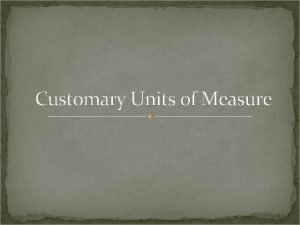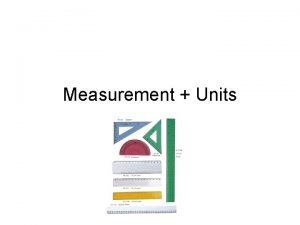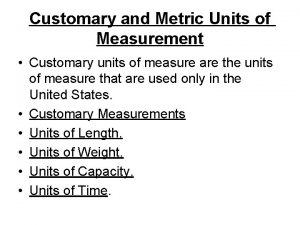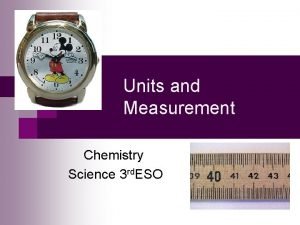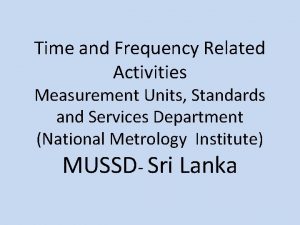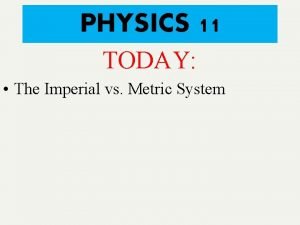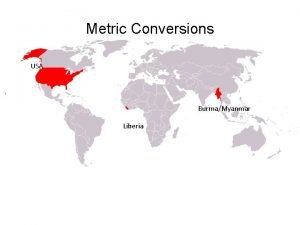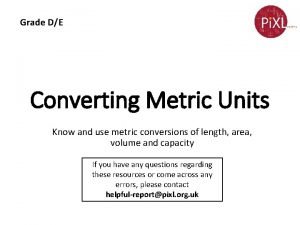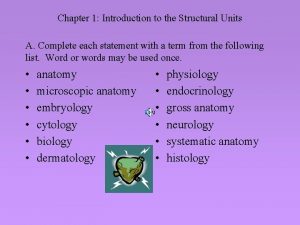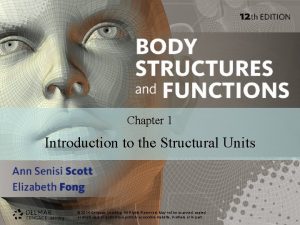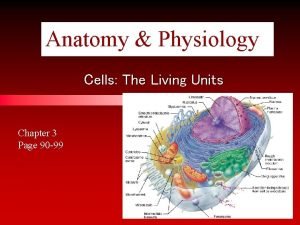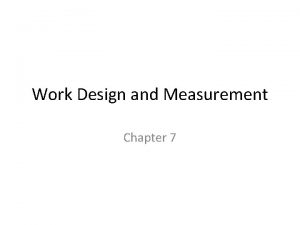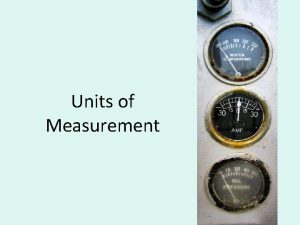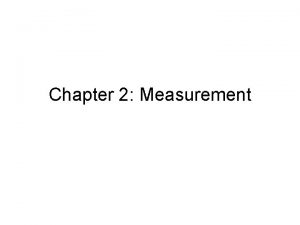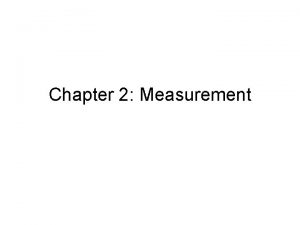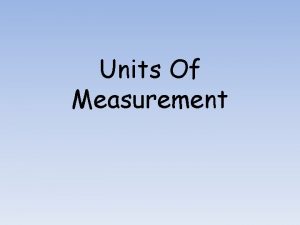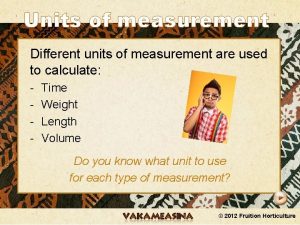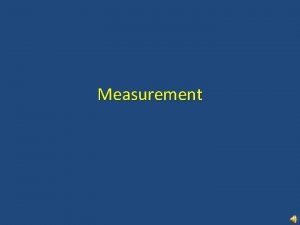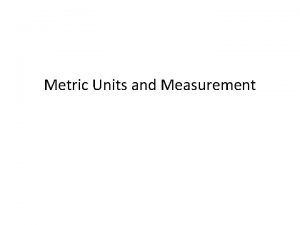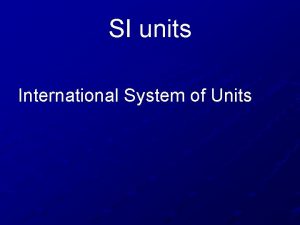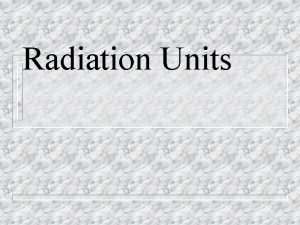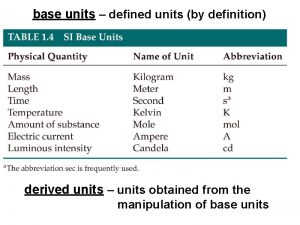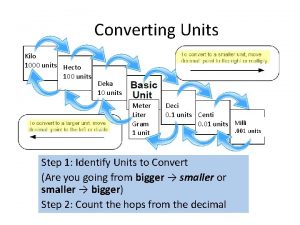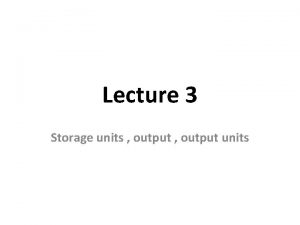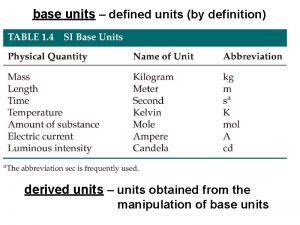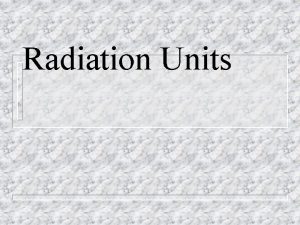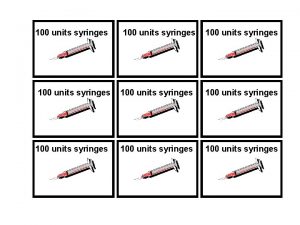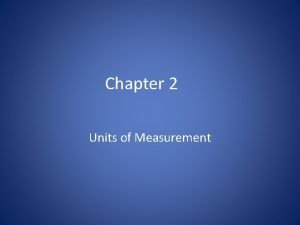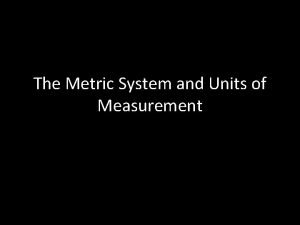Chapter 1 Measurement Units of Chapter 1 Measurement
























- Slides: 24

Chapter 1 Measurement

Units of Chapter 1: Measurement □ The Physical Quantities, Standards and Units □ The international System of units □ The standard of time □ The standard of length □ The standard of mass □ Dimensional Analysis

Learning Goals of this Chapter □ On completing this chapter, the student will be able to : □ Differentiate between the fundamental quantities and the derivative quantities. □ Express the physical quantities using the international system of units. □ Differentiate between the international system of units and the British system of unit. □ Defined The standard of time □ Defined The standard of length □ Defined The standard of mass □ Convert the units of the physical quantities from system to another. □ Determine the dimensions of the physical quantity. □ Check the physical formula using of Dimensional analysis.

1 -1 The Physical Quantities, Standards and Units □ To describe the physical quantities we need to choose a unit that does not differ from a corresponding quantity physically but has a quite definite dimension. □ Every Physical quantity (Y) can be defined as the product of a (unit) multiplied by an abstract number (x): □ Y = X (unit) □ For example: □ Mass = 5 Kg □ Physical Quantities □ Basic ( Length, Mass, Time) □ Derived ( area, speed, density, …. )

1 -2 The International System of Units

Other System of Units □ Gaussian System of Units □ Length in (cm): 1 cm = 10 -2 m □ Mass in (g) : 1 g = 10 -3 kg □ Time in (s) □ British System of Units □ Length in feet (ft): 1 foot (ft) = 12 in = 30. 48 cm □ Mass in Pound (lb): 1 pound (lb) = 453. 59 g □ Time in second (s)

Prefixes □ The standard prefixes are used to designate common multiples in powers of ten. □ 1 angstrom=10 -10 m

1 -3 The Standard of Time □

Typical Time Intervals 1 year (y) = 365. 25 day (d) 1 day (d) = 24 hours (h) 1 hour (h) = 60 min 1 min = 60 second (s) 1 h = 3600 s

1 -4 The Standard of Length □ SI Unit of Length: the meter (m) □ in October 1983, the meter (m) was redefined as the distance traveled by light in vacuum during a time of 1/299 792 458 second. Converting Units of length □ 1 inch (in)= 2. 54 cm □ 1 foot (ft) = 12 in = 30. 48 cm □ 1 yard (yd) = 3 feet = 36 in= 0. 9144 m □ 1 miles (mi) =1760 yards = 5280 feet = 1, 609. 344 m □ 1 m = 3. 281 ft

Typical Length

Problem 1

Problem 2 A light-year is a measure of length (not a measure of time) equal to the distance that light travels in 1 year. Compute the conversion factor between light-years and meters, and find the distance to the star Proxima Centauri (4. 0 X 1016 m) in light-years.

1 -5 Standard Mass □ Unit of Mass: kilogram (kg) □ The kilogram (kg), is defined as the mass of a specific platinum–iridium alloy cylinder kept at the International Bureau of Weights and Measures at Sèvres, France. □ This mass standard was established in 1887 and has not been changed since that time because platinum–iridium is an unusually stable alloy. □ Converting Unit of Mass □ The atomic mass unit u is 1 u = 1. 661 10 -27 kg 1 pound (lb) = 453. 59 g

Typical Mass

1 -7 Dimensional Analysis □ The dimension in physics refer to the type of quantity in question regardless of the unit used in the measurement. □ The symbols we use to specify length, mass, and time are L, M, and T, respectively. □ We shall often use brackets [ ] to denote the dimensions of a physical quantity. For example, the nature of speed v, is length/time, so the dimension of speed [v]=L/T, and nature of the area is length, so the dimension of the area [A]=L 2. □ Any valid physical formula must be dimensionally consistent- each term of the formula must have the same dimensions. □ This type of calculation with dimensions is (dimensional analysis).

1 -7 Dimensional Analysis Quantity The type Dimension Distance Length L Area Length L 2 Volume (Length)3 L 3 Velocity Length/time L/T Acceleration Length/time 2 L/T 2 Force Mass acceleration ML/T 2 Pressure Force/area ML/T 2 L 2 =M/T 2 L Density Mass/volume M/L 3

Problem 4 □ To keep an object moving in a circle at constant speed requires a force called the "centripetal force“. Use the dimensional analysis to predict the formula of centripetal force F, if you know that F depends on its mass m, its speed v, and the radius r of its circular path. Solution: Suppose that F ma vb rc where the symbol “ ” means "is proportional to, " and where a, b, and c are numerical exponents to be determined from analyzing the dimensions. The dimensions of the left hand side: the force [F] = MLT -2

Problem 4 □

Solved Problems □ If you know that the acceleration of gravity in SI unit equals g= 9. 8 m s -2 , find the acceleration of gravity in British System of Units? □ Solution: since

Solved Problems □ If you know that the force is given by Force = Mass x acceleration, find the unit of force in SI unit and the British System of Units? □ Solution: dimension of force The unit of force in SI unit is Newton (N) 1 N =1 kg. m. s-2 The unit of force in British system units is poundal (pd. I) 1 pb. I = 1 Ib. ft. s-2 1 N =1 kg. m. s-2 1 N = 7. 24 Ib. ft. s-2= 7. 24 pd. I or 1 pd. I = 0. 137 N

Ch. 1 Summary PHYSICS AND THE LAWS OF NATURE Physics is based on a small number of fundamental laws and principles. UNITS OF LENGTH, MASS, AND TIME Length Was: one ten-millionth of the distance from the North Pole to the equator Now: One meter is defined as the distance traveled by the light in vacuum in 1/299, 792, 458 second. Mass One Kilogram is the mass of a metal cylinder kept at the international Bureau of Weights and Standards, Sevres, France. Time One second is the time required for a particular type of radiation from Cesium-133 to undergo 9, 192, 631, 770 oscillations.

Ch. 1 Summary DIMENSIONAL ANALYSIS Dimension: The dimension of a quantity is the type of quantity it is, for example, Length [L], mass [M], or time [T]. Dimensional Consistency An equation is dimensionally consistent if each term in it has the same dimensions. All valid physical equations are dimensionally consistent. Dimensional Analysis: A calculation based on the dimensional consistency of an equation. CONVERTING UNITS Multiply by the ratio of two units to convert from one to another. As an example, to convert 3. 5 m t feet, you multiply by the factor (1 ft/0. 3048 m) □ 1 yard (yd) = 0. 9144 m 1 inch (in)= 2. 54 cm □ 1 miles (mi) = 1609. 344 m 1 yard (yd) = 3 feet (ft) □ 1 foot (ft) = 30. 48 cm 1 m = 3. 281 ft

Homework 1. The earth is approximately a sphere of radius 6. 37 106 m. (a) What is its circumference in kilometers? (b) what its volume in cubic kilometers? 2. A room has dimensions of 21 ft 13 ft 12 ft. What is the mass of the air it contains? The density of air at room temperature and normal atmospheric pressure is 1. 21 Kg/m 3. Show that v=vo+at is dimensionally consistent, where v and vo are velocities and a is the acceleration and t is the time. 4. Show that x=xo+vot+at 2 is dimensionally consistent, where x and xo are distances and vo is a velocity and a is the acceleration.
 Botox dosage chart
Botox dosage chart Variable costing income statement
Variable costing income statement Gallon man chart
Gallon man chart Momentum units physics
Momentum units physics 3 units of linear measurements in metric system
3 units of linear measurements in metric system Customary units of measurement
Customary units of measurement Typical room height appropriate metric unit
Typical room height appropriate metric unit Customary units of measurement
Customary units of measurement Deci centi mili
Deci centi mili Units of measurement in physics
Units of measurement in physics Physical quantity table unit of measure
Physical quantity table unit of measure Customary units of time
Customary units of time Pico unit
Pico unit Basic conversions
Basic conversions Mussd
Mussd Metric system of measurement
Metric system of measurement Metric conversion ladder method
Metric conversion ladder method Units of length
Units of length Chapter 1 introduction to the structural units
Chapter 1 introduction to the structural units Introduction to the structural units
Introduction to the structural units Chapter 1 introduction to the structural units
Chapter 1 introduction to the structural units Rough er
Rough er Chapter 3 cells the living units
Chapter 3 cells the living units Mitosis
Mitosis Work measurement techniques
Work measurement techniques



